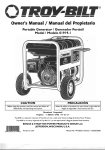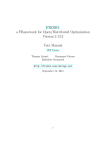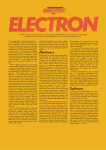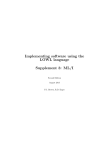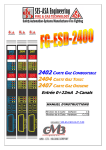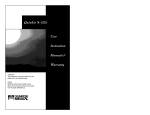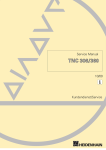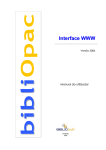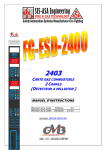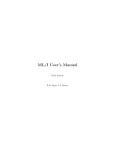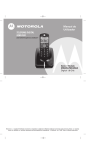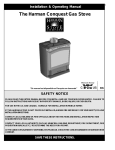Download The ML/I Macro Processor
Transcript
Here an unconditional statemenl; plus a conditiorm,1 expression has become a conditional statement.
Fortunately both of these situations have beert ruled out
by Section 4.7.5.2.
Condusion
l:or centuries astronomers have given the name ALGOL to
a star which is also called Medusa's head. The author has
tried to indicate every Mmwu blemish in [2]; and he hopes
that nobody will ever scrutinize any of his own writings as
meticulously as he and others have examined the ALGOL
Report,.
RECE~VF:~ JANUARY1967; ~mVlSED JUI,Y 1967
REFERENCES
1. NaUR, P. (Ed.) Report on the Mgorithmie language At,Got,
60. Comm. ACM 3 (1960), 299--314.
2. Namt, P., AND WOODaEa, M. (Eds.) Revised report on the
algorithmic language A~aoI, 60. Comm. ACM 6 (1963), 1-20.
The ML/I Macro Processor
I:). ,l. BnowN
University Mathematical Laboratory, Cambridge, England
A general purpose macro processor called ML/I is described.
ML/I has been implemented on the PDP-7 and I.C.T. Atlas 2
computers and is intended as a tool to allow users to extend
any existing programming language by incorporating new
statements and other syntactic forms of their own choosing
and in their own notation. This allows a complete user-oriented
language to be built up with relative ease.
Introduction
A macro is basically a means of extending an existing
programnfing language, called the base language, by introducing a new syntactic unit which is describable in terms of
the existing syntactic units of the base language. This
paper is concerned only with macro processors which
operate on text and act as a preprocessor to the compiler
for the base language. Most existing macro processors have
a fixed base language, usually an assembly language, and
the macro processor and tile base language processor are
regarded as a single piece of software, as exemplified b y the
term "macro-assembler." One of the best knowr~ macroassemblers is Macro FAr [1]. Most macro-assemblers require that macros expand into a series of statements; it is
not possible, for instance, to use a macro to generate the
address field of an instruction.
As a very elementary example of the use of a typical
macro-assembler, assume t h a t a user wished to introduce
a single statement thal~ would move an item from one
storage location to another on a machine that required two
618
C o m m u n i c a t i o n s of the A C M
3. Aj~I~,AIIAMS,P, W. A final solution to the da;@ing else c.f
ALGOi,60 and related languages. Comm. ACM 9 (i966), 679~
682.
4- MJ4;~>q~n,J- N. Discussion question. Comm. ACM 5 (I9(;i), 7I
5. t.(NTJ'r~LD. E. On l,he translatiorl of languages froi~a l~ff~:. ,
righL jr@ Congr. 8 (1965), 607-639.
6. [)~,J~'~s~r~¢a,E.W. Letter to the edi[or, Comm. ACM 4 (tgrfl).
502-503.
7. ~EikVENWOR,TII, B. M. FORTRAN IV as a syrttax la.~g~.~age.
Comm, ACM 7 (1964), 72-80.
8. KNU:el~, ])- :E., AND MERNER, J. N. ALGOL60 confide~tial,
Cornm. ACM 4 (1961), 268-272.
9. INGERMAN P. Z., ~kND MERNER, g. N,
10.
11.
12.
13.
Suggeseions o n :\~,(;()~:,
60 (Rome) issues. Comm. ACM 6 (1963), 2@23.
RANDELL, B., AND RUSSELL, L. 5. ALGOL 60 jrmplem~vn~atfoa,
Academic :Press, London, 1964.
NAUR,P. Questionnaire. ALGOL Bullegn 1~, gegneee~r~.ler~,
Copenhagen, Denmark, 1962.
B5500 Information processing systems reference matmal.
Burroughs Corp., 1964.
VAN WIJNGAARDEN, A. Switching and progrararming. I::~
H. Aiken and W. F. Main (EDs.), Switching Theory i n Space
Technology, Stanford U. Press, Stanford, 1963, pp. 275-28g.
instructions to achieve this. To do this he would deft:a<, ~
macro, give it a name, MOVE, say, and define t h e taro
requisite instructions as the replacement text of t h e macro.
Having defined his macro, tile user could tlhe~ treaT:
M O V E as if it were an assembly language s t a t e m e n t , and
the macro processor would expand this into the t w o givm~
instructions. The M O V E statements are called mac'ro c:alL~
altd have form:
MOVE argument I, argument 2
I n the typical macro-assembler the syntax of m a c r o s is
very rigid. Each line of input text must be either a state,,
ment in the base language or a macro call. The argumem:~
of macro calls are separated by a fixed delimiter, the
comma, and the closing delimiter (the symbol u s e d ~o
indicate the end of a call) is typically either a s p a c e o r ~he
end of a line.
Several macro processors with more general p r o p e r t i e s
than the basic macro-assembler have been p r o d u c e d
Among these are X P O P [2], Wise [3], LiMP [4], GPS"[ [511
and TI~ae [6]. These have extended the basic c o n c e p t i~t two
main ways. Firstly, the user has been allowed to d e f i n e his
own notation for writing macro calls. This cotation m i g h t ,
for instance, be something approaching the "English La~>
guage or alternatively might be close to the l a n g u a g e of
algebra. Secondly, the macro processor has been m s . d e ir~dependent of the base language and its processor. I n l,h!is
ease the same macro processor can act as a p r e p r o c e s s o r to
any number of different languages, and there is no restrLclion on the syntactic forms of the base language which
m a y be expanded.
M L / I incorporates both of these extensions a n d is
intended to allow the user to extend a n y language, using
his own notation. The only restriction on n o t a t i o n is that.
macro calls must cmmnenee with the macro n a m e . 5 l L / ' i
Volume 10 / Number 10 / October, 1967
i
recog!fizes a macro by the occurrertce of its mime and a
macro call. is i;aket~ as tlte text fl'om the macro name up to
its closing delimiter. This contrasts with macro processors
such as Wisp and :LIMP where macro calls are recognized
by comparing each line of input text with a number of
templates.
Main F e a t u r e s of M L / I
This paper will not attempt to give a detailed description
of M L / I but ~ t h e r will describe its main features. For de~ails the reader is referred to tim User's Manual [7]. Firstly,
'd:~egeneral form of a macro will be described together with
examples of its applications. M L / I Mlows arty sequence of
characters to be used for each delimiter. The macro name
is regarded as delimiter number zero. Hence the user could
specify TO attd a semicolon as delimiters of his MOVE
macro and write his calls:
MOVE argument 1 TO argument 2 ;
tlmugh this in itself could hardly be claimed as a dramatic
improvement. The special feature of M L / I is that the user
specifies a delimiter structure for each macro wtfich makes
it possible for each macro to have any number of alternative patterns of delimiters. The purpose of the delimiter
structure is to define the name or names of the macro and
1~odefine for each delimiter a successor or set of alternative
successors. A successor is the next delimiter to be searched
for when scanning a call. A dosing delimiter may be considered as having a null successor. As an example, consider art I F macro which has alternative forms:
%) It p argument 1 = argument 2 THEN argument 3 END
<~' (b) iF argument 1 = argument 2 THEN argument 3 ELSE
argument 4 END
Ia the delimiter structure of this macro each delimiter has
a unique successor except for the delimiter T H E N which
has the alternative successors E N D and ELSE.
The above I F macro could be extended by allowing as
the first delimiter a number of alternative relational operators to "equals." This could be done by specifying the set
of relational operators as alternative successors to IF.
Each relational operator would have T H E N as its successor. In order that a meaning can be ascribed to different
delimiter names, M L / I contains a facility for placing
conditional statements, operative at macro generation
time, within the replacement text of a macro. These conditional statements can be used to make the form of the code
replacing a macro call dependent on the delimiters used in
the call.
Delimiter structures can be designed to allow macros
with an indefinitely long list of aNuments. Assume, for
example, that it is desired to extend further the I F macl~o
by allowing between I F and T H E N a whole series of rela.
tions connected by, say, AND or OR. This could be
achieved by defining the successors of each of the relational
operators to be AND, OR, or T H E N . The successors of
0 R and A N D would be the set of relational operators, thus
causing the delimiter structure to loop back on itself.
!
"Volume 10 / Number 10 / October, 1967
M L / I allows macro ~'flls to be nested within the arguments of other macro calls. Hence it would be quite possible to write nesl,cd calls of the I F macro. The method of
se~rching for delinfiters takes care of nested calls.
Before the more basic details of M L / I are described, a
few more examples of its applications will be considered in
general terms in order that the reader may get sonic sort of
a feel for the kind of macro that is normally defined.
Example 1. I t is possible to design a set of macros that
would be useful for referencing individuM fields in blocks
of data. Thus F I E L D and S E T macros could be designed
that would allow the user to define the fields of his data
blocks and then to refer to these fields. His program might
read (where, for the sake of clarity, the delimiters of the
F I E L D macro have been italicized):
FIELD FATHER IS WORD 1 ;
FIELD MOTHER IS WORD 3 ;
FIELD AGE IS BITS 6 TO 12 OF WORD 4 ;
SET X = AGE(FATHER(MOTHER(Y) ) );
The action of the F I E L D macro would be to set up a
macro definition whose name was derived from the first
argument of F I E L D . Thus the third call of F I E L D would
define a macro with name " A G E ( " and with closing delimiter ")". The replacement text of this macro would
generate code to reference the desired field of the
designated data block.
Example 2. I t is possible to write a macro of form:
LOAD argument ;
where the argument is a general arithmetic expression.
This macro would generate code to load the value of the
arithmetic expression irtto an accumulator. The argument
could be analyzed by defining the character "(" as a macro
name with a right parenthesis as its closing delimiter and
specifying all the permissible arithmetic operators for the
intervening delimiters, of which there could be any nmnber.
Since M L / I is independent of the base language, it is
intended that it be used as a common preprocessor to all
the compilers and assemblers available at art installation,
in the same way as each compiler and assembler might use
a common loader. In general it is true to say that the higher
level the language, the less need there is for macro facilities.
However, even in the most comprehensive high-level languages, macros are useful for introducing statements
specially designed for the user's particular hem of application.
The above examples have illustrated the primary use of
M L / I , namely to allow any existing programming language to be extended to suit a particular user's requirements. This form of extension could be carried to the level
where the extended language could be considered as a
language in its own right.
The efficiency of code generated by M L / I depends how
well the macros are designed. There are macro-time variables and conditional facilities to help eliminate the sort of
inefficiencies that occur at boundaries between macros.
As regards speed, M L / I would be considerably slower than
C o m m u n i c a t i o n s of the ACM
619
a special purpose compiler for a language. Not(,., [~owever,
t h a t it is n o t intended to be a general purpose compiler.
I n s t e a d of designing a new language and writing a compiler
for it, the idea is for the user to start at the other end, as it
were, and extend a n existirtg language to meet his requirements.
T h e usefulness of M L / I is not confined to language
extension. I t can also be used for some applicati(ms in. text
editing. For instance, it is now being used ~s an aid to
converting f r o m FORTI~AN IV to a dialeet of .FowraAN II.
H e r e M L / I performs the transformations of which it is
capable, for instanee reeognizing declarations of logical
variables a n d converting statements involving them into
corresponding arithmetic statements. In those eases where
if, cannot p e r f o r m the required transformation it places a
special m a r k e r beside the FOremAN IV statement.
Introductory Details of ML/I
M L / I is fed some source text. I t performs some t,ransformations on this text and generates some output text,
which is, in turn, norrnally fed to some eompiler or assembler. These transformations are specified b y constructions, which are usually defined at the start of the sourer
text. The m o s t i~g)ortant type (ff construction is the
nlaero.
T h e character set of M L / I will valT between irnplemenrations but it should contain the letters and mmtbers and
some punctuation characters. A punctuation character is
a n y character t h a t is not a letter or number. "Space" or
" b l a n k " is t r e a t e d as a punctuation character and it is
usually convenient to assume there is a eharacter called
"newline" a t the end of each line of text. (This character
physieally exists if input is t'mnl paper tape. I n the case of
card input it would have to be specially inserted by the
input routine.) However, in this paper, for reasons of
layout, it will be assumed that "newline" is not a character. M L / I treats text as a sequence of atoms rather than
as a sequence of individual characters. An a t o m is defined
as a single p u n c t u a t i o n character or a sequence of letters
a n d / o r numbers surrounded by punctuation charaeters.
T h u s the piece of text which follows consists of the six
atoms: comma, D O G , space, 23, plus, and C8.
,DOG 23+C8
Any sequence of atoms nmy be defined as the name of a
construction or as the name of arty of the other delimiters.
I n general e v e w time the name of a macro is encountered
during the scanning of text it is taken as the start of a
macro call a n d a seareh is made for the remaining delimiters. The s a m e applies to other constructions. Thus if
D O G were a macro with (...losing delimiter plus, then the
a b o v e text would contain a call of it. However, if DO were
the nmero n a m e , the above text would not eontain a call of
it since DO is rmt an a t o m of the text.
The p a r a g r a p h s whieh follow describe the other types of
construction in addition to macros.
620
C o m m u n i c a t i o n s of the ACM
Consider t])e replaceme~it text of the M()'\@] macro
whi6h ]m,s ~Jre~xiy been used as an example. (This examlje
~md .~ome subsequerv~ ones will use t)1)}<7 Ass(~mbly l~am.
gnat(< II o wever, it is not assumed that the reader is fi.~milJar with. the [)I)P-7 and each instruction will kw, ex/)lained.)
The replacement text of the MOVE macro (ecmsists of tl~e
two followb~g statements:
LAC argu'ment 1 /Load aecumul~tor with first argument,
DAC arfi~ment 2 /Deposit accumulator ~'~t second ~rgument.
I t is necessatyy to indicate to M L / I that it must hlsert
the appropriate aNurnent at the appropriate point. This is
done by a construction called an in.serf which has a name
and a (.,.losing delimiter. I t will be assumed in the rest of
this paper that the character " : " has bee~x defined as a~
insert name with a period as its closing delimiter. Between
the insert name and its delimiter a designation is written
to indicate what to insert. Ira particular, "A" stands for
aNument. The replacement text of iVfOVE would be
written:
LAC :kl.
DAC :k2.
Several other elements in addition to arguments may be
inserted and these are described later.
Skips
I t may be that tire user does not wish certaitt oeettrrettees
of macro names in his text to be taken to mean th.e ma(...ro
is to be called. This might apply, for instan(ee, within comments or character string literals. In this case s/~:ips are
used to inhibit macro repla(...ement within the required
context. Thus if tire base language were P L / I a skip name
" / * " with closing delimiter "*/" might be defined, since
these charaeters are used to enclose P L / I conuneats. Each
skip fins an associated set of options which determine
whether the skip :is to be copied to the output text or
deleted during macro expansk)n. I t is possible to copy the
delimiters and delete the intervening text or vice-versa. In
most applications tire user will require a special skip name
and elosing delimiter called gteral brackets. The options for
literal brackets are sot so that the brackets are deleted but
the intervening text is copied literally to the o u t p u t te.~t.
I t will be assumed in the rest of this paper that the characters "(" and "}" have been defined as literal brackets.
With this assumption, an occurrence of (DOG) in the
source text would give rise to D O G in the output text
irrespective of whether D O G was a macro name.
Warning Markers
I n some applications it is inconvenient to have every
occurrence of a macro name outside a skip taken as the
beginning of a call. In these eases M L / I can be placed in
warning mode by defining some a t o m as a warning marker.
If M L / I is in warning mode all macro ealls must be preceded by a warning marker and all macro names not preeeded by a warning marker are treated literally. If M L / I
Volume 10 / N u m b e r 10 / October, 1967
is not i:~). w~rning mode, macro names are essentially reserved words and if t h w xre used fox' any other puIpose
they must be enclosed in skips. ]Tt will be assumed in examples il:~ the resb of this p a p e r that h/[L/I is not in warning
mode.
T e x t Eval,~a~,ion
T h e environment consists of all the constructions defined
by the user, together with the system macros, which will
be described latex'. The process of scanning a piece of text
Io expand macro calls and deal with skips and inserts is
called evaluating the text. T h e text generated as a result of
this evaluation is called the value. The value of a piece of
text depends, of' course, on the environment.
Constructions m a y be nested in any desired way. When
MJ,/Jl encounters a macro call, it evaluates the replacement text in the same way as it evaluates the source text.
The replacement text m a y itself contain macro calls and
recursion is permitted. T h e arguments of macros are
evaluated when they are inserted rather than when the
call containing t h e m is scanned. Thus they are "called b y
n a m e " rather t h a n "called b y value." This fact is useful if
M L / I is generating assembly code as it is possible to examine the context in which the code is to be placed
and generate optimal code accordingly.
Further Facilities ibr Inserts
I t }ins been seen t h a t arguments and macro variables
m a y be inserted into text. This section describes the complete :facilities offered by inserts.
T h e general form of the designation of an insert consists
of a flag followed by a subscript expression. The subscript
expression m a y consist simply of a positive integer, as in
the previous examples, or it m a y be the name of a macro
variable or an arithmetic expression involving macro
variables a n d / o r constants. Thus if T1 had its initial
value then AT1 would reference the last argument and
A T 1 - 1 would reference the next to last argument. T h e
following are the possible flags t h a t can be used for inserts,
together with a description of each:
A.
D.
--argument.
--delimiter.
WA, WD. --argument or delimiter in its written form. The argument or delimiter is not evaluated but is inserted
literally.
null.
--the numerical veJue of the subscript expression is
inserted.
L.
--macro label. This type of insert "places" a macrotime label which may be the subject of a macro-time
GO TO statement; it is a speciM type of insert in that
it does not cause any output text to be generated, i.e.,
its value is null.
Macro Variables
M L / I contains some " m a c r o - t i m e " integer variables,
i.e., variables operative during macro generation. There
are facilities for the user to perform arithmetic on these
variables and to insert their values into his text. There are
two types of macro variables as follows.
Permanent variables. These are called P1, P2, etc. T h e y
are reserved a t the start of a program and remain in existence throughout. T h e y h a v e global scope.
Temporary variables. These are called T1, T2, etc.
Each time a user-defined macro is called, a n u m b e r (deiined by the user) of t e m p o r a r y variables is allocated.
These are local to the current call. The first three temp o r a w variables are initialized by M L / I in the following
way:
T1 contains the n u m b e r of arguments.
T2 contains the n u m b e r of macro calls performed so
far.
T3 contains the current depth of nesting of macro
calls.
T h e initial value of T2 is a number unique to the current
call and is useful for generating unique labels. If the replacement text of a macro contains a label it is imperative
t h a t a different n a m e be generated for the label each time
the macro is called. This can be achieved by writing the
label as:
LAB :T2.
( R e m e m b e r t h a t the colon is assumed to be an insert n a m e
in thin and all subsequent examples.) A later example
illustrates the use of this feature.
V o l u m e 10 / Number 10 / October, 1967
Operation
Macros
M L / I contains a n u m b e r of built-in macros called operation macros. Operation macros are used for such purposes
as defining new constructions, performing macro-time
arithmetic and changing the position of scan (using the
macro-time GO T O statement). T h e names of operation
macros all begin with the letters " M C " so t h a t they m a y
readily be differentiated from user-defined macros. An
example of an operation macro is M C D E F , which is used
for defining macros. This has form:
MCDEF argument 1 AS argument 2 ;
T h e first a r g u m e n t must be in the form of a structure
representation, which specifies the delimiter structure of
the macro being defined. I n the simplest case, where all
the delimiters are fixed, a structure representation is
specified b y writing the delimiters in the order in which
t h e y am to occur. The macro name, which is regarded as
delimiter n u m b e r zero, comes first. The second argument
of M C D E F specifies the replacement text of the macro
being defined. T h u s if " T O " and semicolon were chosen
to delimit the ends of the two arguments of MOVE, its
definition would be written:
MCDEF MOVE TO ; AS
( LAC :A1.
DAC :A2.
);
and a call of form:
MOVE X TO TABLE + 6;
C o m m u n i c a t i o n s of t h e ACM
621
foUewing macro to convert fully parenthesized aigebraic
notation to Polish Prefix notation.
would expand into:
LAC X
DAC TABLE q- 6
MICDEF (OPT -k- 0f% .... OR.. OR / ALL) AS ( :D1. :A1. :A2..
Note that the replacement text of M O V E has been enclosed in literal brackets in the above definition. This is
beeause all arguments to operation macros are evaluated
before being processed. Assume t h a t the literal brackets
had been omitted. T h e n in evaluating the second argumertt
of M C D E F , M L / I would have tried to perform the inserts.
This would have unfortunate results since the inserts
should be performed when M O V E is called, not when it is
defined. In its correct form, with the literal brackets
p resent, the evaluation of the argument leads to the literal
brackets being deleted and the enclosed text being copied
literally. This text then becomes the replacement text of
the M O V E macro. T h e reader is probably tempted to ask
why operation macro a N u m e n t s are not treated literally
by the system in order to avoid the necessity of using
literal brackets, but there are m a n y examples where the
dynamic element is vital.
Structure
Representations
for M o r e C o m p l i c a t e d
Here the left parenthesis is the macro name. T h e rep[ac~.
ment text cor~sists of the first delimiter followed by t}>
first argumerR followed by the second argument,
(e) If a delirniter is at the end of a branch, its successor
is normally taken as the successor of the occurrence of ALI,
corresponding to the branch. Tlms in the a b o v e Polish
Prefix example each of the alternative arithmetic opera.
tots has a right parenthesis as its successor. Howev~r, a
delimiter at the end of a branch can be given a diffcre~t
successor by writing the name of a node at the end of a
branch. A node is designated by the letter " N " followed
by a positive integer. The successor of the delimiter is then
taken as the successor of the node, which is specified by
writing the name of the node in front of some delimiter
specification in the structure representation. T h e followi~g
example illustrates the use of nodes. Assume a macro
called M I N allows any number of arguments separ:~ted
by commas and terminated by a semicolon. I t s structure
representation would be written: M[N NI OPT, N1 ()R; A],t~
Cases
The exact details of how to write structure representations in the general case are to be found :in the User's
Manual and this paper will confine itself to a basic outline.
There are certain reserved words in structure representations. Among these are: W I T H , OPT, 0 I t , ALI; and any
a t o m consisting of the letter " N " followed by an integer.
(The names of reserved words can be changed dynamically
by the user, if be desires.) W I T H is. used to specify delimiters that consist of more than one atom. For example,
if a delimiter consists of the a t o m s AI, A2 . . . . , Ak, then
this is specified by:
A1 WITti A2 WITH ... WITtI Ak
The remahfing reserved words are used to specify
branches and nodes of the delimiter structure.
As has been seen, the purpose of a delimiter structure is
to specify a successor or set of alternative successors for
each delimiter, in a structure representation each specification of a delimiter is immediately followed by a specification of its successor. This successor m a y be defined in any
of the following ways:
(a) If there is a single possible successor, as in the case
of the delimitm~ of the M O V E example, this is specified
simply by writing its name. (It is convenient to imagine a
special symbol "null" occurs at the end of each structure
representation. Any delimiter with "null" as its successor
is a closing delimiter.)
(b) If there am alternative successors, this is specified
by writing:
OPT bran& 1 OR branch 2 OR branch n ALL
A branch may be a single delimiter specification or a structure in itself. An example of the use of this faciliW is the
622
Communications of the ACM
This is interpreted thus. Tlm successor of M I N is eith<,r a
comma or a semicolon. Node N1 is to be associated wish
these alternatives since N I has been written before the
specification of the alternatives. If a comma is found as a
delimiter, its successors am the suceessors of N1, namdy
either a comma or a semicolon. If a semicolon is found, its
successor is the successor of ALL, namely " n u l l . "
Use o f M a e r o - T i m e S t a t e m e n t s
I n simple macros such as MOVE, the replacement te.vt
is a fixed skeleton of code which is to replaee each call.
This is obviously not adequate for more sophisticated
eases. Consider the I F macro used earlier as an example,
which had alternative forms:
(a) IF argument i = argument 2 THEN argument 3 END
or (b) IF argument 1 = argument 2 THEN argument 3 ELSE
argument 4 END
Clearly the replacement text of I F must be m a d e to generate different code in the two eases. This can be do:he by
using the macro-time GO TO statement, M C G O , in its
form: MCGO argument 1 UNLESS argument 2 = argument 3;
The definition of I F is written as follows:
5.ICDEF IF = THEN OPT ELSE END OR END ALL AS
(
LAC :A1
/Load first argument.
SAD :A2.
/Skip if it differs from the seceded
argument.
SKP
/Equal ease: skip one instructiom
JMP XX:T2. /Unequal ease: jump over inserted
code.
:A3.
/Inserted code.
5,ICGO L1 UNLESS :D3. = ELSE; /Macro-time jump if
else clause is absent.
JMP YY:T2. /Jump over else clause.
Volume 10 / Number 10 ] October, 1967
XX :T2.,
:A4.
yY:T2., MCGO 12;
/Insert else clause.
/Macro-time jump to end of replace-
:L1.XX:T2., :L2. );
/Placing of macro-time labels.
ment text.
Note that (~he second argument of MCGO, which is
":D3.", is evaluated before being compared with the
character string " E L S E " . This evMuation causes the text
of the third delimiter to be inserted and to take part in
the comparison. Note also the use of the initial value of T2
to generate unique labels. The following two successive
calls of the I F macro:
IF A = B THEN JMS SUB
END
IF PIG = DOG THEN LAC C
DAC D
ELSE LAC Y
DAC Z
END
New constructions may be defined at any time during
text evMuation but, M L / I being a one-pass system, definitions only apply to text that comes after them. I t is possible
to redefine a construction and individual constructions
,nay be deleted by redefining t,hem to have a null effect.
Constructions may be defined as local to a piece of replacement text or even local to the evMuation of an argument.
I t is possible to use a macro to set up the definition of
another mac1% and this is useful in dealing with declarative statements. Thus D E C L A R E could be a macro such
that if, for example, the statement:
DECLARE X REAL
were encountered, then the D E C L A R E macro would set
up a definition of X as a macro, which might, for instance,
take the form:
MCDEFG X AS ( 100 MCSET P1 = 6 ; );
would generate the code:
LAC A
SAD B
SKP
JMP XX1
JMS SUB
XX1, LAC PIG
SAD DOG
SKP
JMP XX2
LAC C
DAC D
JMP YY2
XX2, LAC Y
DAC Z
YY2,
Scope o f D e f i n i t i o n s
/First call.
/Second call.
The two macro-time statements M C S E T (the macrotime assignment statement) and MCGO can be used to
form maero4ime loops, which are useful in processir~g
macros with a variable number of arguments. The following macro, which is useful in a number of applications,
illustrates the macro-time loop. The macro, which has the
composite name " I N D E X (", successively compares its
first argument with each succeeding argument until a
:match is found, attd returns as its value the number of the
matching argument.
MCDEF INDEX WITH (N1 OPT, N1 OR) ALL AS
(
MCSET T2 = 2;
:L2.
MCGO L1 IF :AT2. = :A1.;
MCSET T2 = T2 -t- 1;
MCGO L2;
:L1,
:T2. );
/Insert value of T2.
This macro can be used for switching. Assume it is
desired to test the second delimiter of a macro and branch
to macro-time label L2 if the delimiter is a plus sign, to
L3 if it is a minus sign, and so on. Then the following statement achieves this:
MCGO L INDEX (:D2., +, - - , . , / ) ;
Volume 10 / N u m b e r 10 / October, 1967
( M C D E F G is the same as M C D E F except that the
definition is global rather than local to arty containing
macro.) This definition would cause each subsequent occurrence of X to be replaced by 100 and each call of X
would, as a side-effect, set tile permanent variable P1 to
value six. The side-effect could be used to convey the
information that X was of type "reM".
Implementation
M L / I has been implemented on the PDP-7 and I.C.T.
Atlas 2 computers. I t occupies about three thousand words
of storage. I t is planned to write the logic of M L / I in a
macro language so that, by suitably coding the basic
macros and running the logical description through IVIL/I
itself, it is possible to generate code for any machine. I t is
hoped that this technique will enable M L / I to be transferred to a new machine in about one man-month, even
allowing for the multitude of unforeseen difficulties this
kind of operation always involves.
RECEIVED JANUARY, 1967; REVISEDMAY, 1967
REFERENCES
1. FAP: reference manual. Form C28-6235, IBM Programming
Sys. Publ., Poughkeepsie, N.Y., Sept. 1962.
2. HALVERN,M.I. XPOP: a meta-languagewithout metaphysics.
Proc. AFIPS 1964 Fall Joint Comput. Conf., Vol. 26, pp. 5768.
3. WILKES,M.V. An experiment with a self-compiling compiler
for a simple list-processing language. Annual Revue in Automatic Programming, Vol. 4. Pergamon Press, Oxford, England,
1964.
4. WAITE, W. M. A language-independent macro processor.
Comm. ACM 10, 7 (July, 1967), 433-440.
5. STmtCHEY,C. Ageneral purpose macrogenerator. Comput. J.
8, 3 (Oct. 1965), 225-241.
6. MooERs, C.N. TRAC, a procedure describing language for the
reactive typewriter. Comm. ACM 9, 3 (Mar. 1966), 215-219.
7. BROWN, P. J. ML/I user's ~uanual. University Math. Lab.,
Cambridge, England, July 1966.
C o m m u n i c a t i o n s of t h e AClVI
623






